Self-propelled artillery for assault
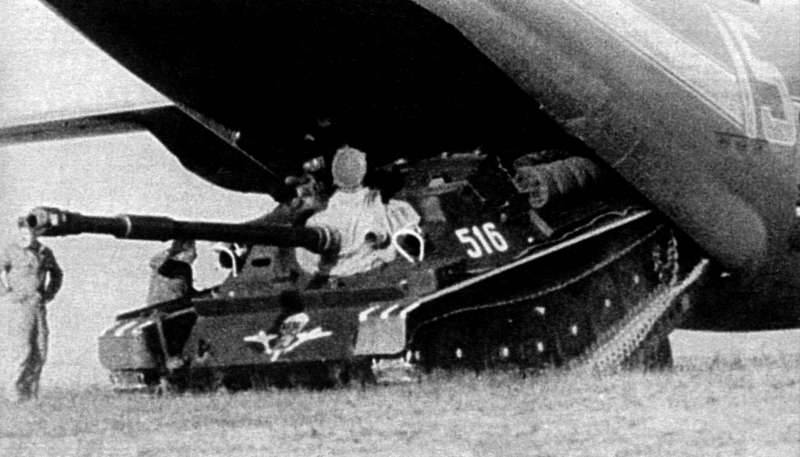
In October, 1946, in Gorky, at the plant №92 named after I.V. Stalin began to create 76-millimeter gun, and at the plant number XXUMX (Mytischi) - the chassis for a light airborne self-propelled artillery installation (SAU). Chassis development was led by one of the best designers of the USSR N.A. Astrov, who had extensive experience in the development of light armored vehicles. In March 40 of the year, the draft design of the “1947 object” was completed, and in June of the same year those. project. The plant No.570 in November 92 of the year produced two prototypes of the gun LB-1947С, transferred to the plant No.76. The first prototype self-propelled at the plant collected in December. In 40, factory testing began. In the middle of the year, a prototype was tested in Kubinka at the NIIBT test site and near Leningrad at GNIAP. By the end of the year, the LB-1948С gun was brought to the series. She received the designation D-76C.
From July to September 1949, in the 38 airborne corps (Tula region), military tests passed four prototypes of the ACS. 17 December 1949, the Council of Ministers signed a decree according to which the unit was adopted under the designation ASU-76 (“airborne self-propelled unit, 76-mm”). ASU-76 was the first to enter service with the domestic armored vehicle designed specifically for the Airborne Forces.
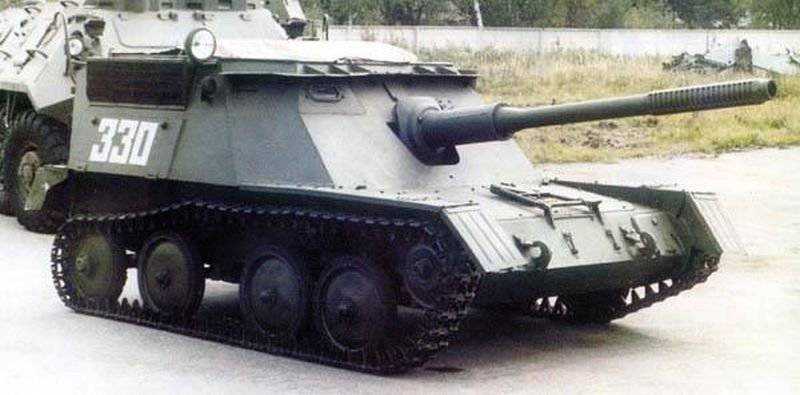
The D-56С gun (an analogue of the D-56Т gun, mounted on the PT-76 tank) was installed in the fixed wheelhouse open from above. It was equipped with a jet-type muzzle brake. The fire was conducted from closed positions or direct fire. For aiming the OPT-2-9 sight was used. The ammunition consisted of armor-piercing and sub-caliber armor-piercing shells. The maximum firing range - 11,8 thousand. M, direct fire - 4 thousand. In the front of the case was mounted folding support, which was attached to the gun. The gun was removed from the stopper without leaving the crew.
The car body is welded. 13-mm armor provided protection against shell fragments and small-arms bullets. weapons. The crew got into the car through the cabin and the aft door.
The layout of ACS-76 was not quite normal. The power unit was located on the right, in the aft hull. The GAZ-51E carburetor engine, the main clutch and the four-speed gearbox were mounted in a single unit. The exhaust pipe and the air intake were located to the right in the aft cabin. The remaining transmission units were in front of the hull. To facilitate engine starting at low temperatures, a heater heater with a blowtorch was built into the cooling system.
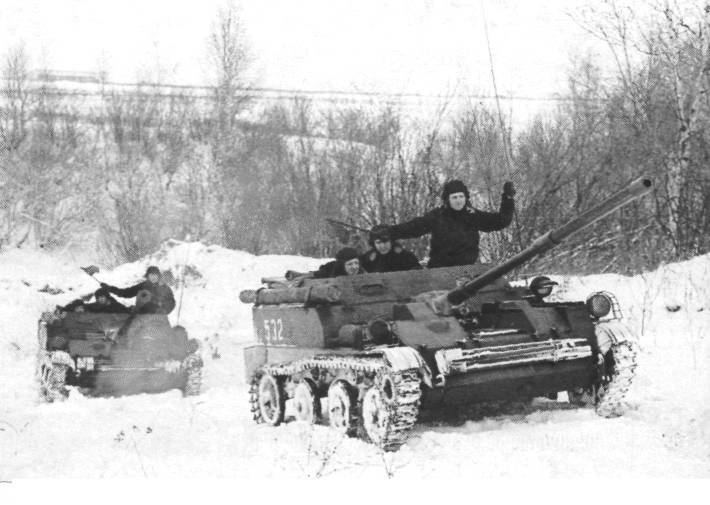
To improve the maneuverability and stability of self-propelled guns when shooting, the rear guide wheels were lowered to the ground. Stability was also achieved by introducing brakes into track rollers and self-braking guide wheels. The car was equipped with a radio station 10РТ-12 and a tank intercom.
Despite the fact that the ACS-76 was adopted, it did not enter mass production. In the absence of aircraft of the necessary payload, it was supposed to land it with the Il-32 glider developed by the OKB SV. Ilyushin. The glider was built in 1949 year (with a load capacity of up to 7 thou. Kg, he was able to transfer one ACS-76 or a pair of ACS-57). However, the IL-18 has not been finalized. Two head ACS-76 did not pass field tests in the amount of the warranty period of operation. In August, the 1953 year of work on this machine turned, especially since the mass production of the 57-millimeter airborne self-propelled artillery began.
ACS-57
Work on the 57-millimeter self-propelled gun, which had greater mobility compared to the 76-millimeter, went in parallel. In addition to the Astrov Design Bureau, work was carried out by other design teams.
Back in 1948, they developed the ASU-57 variant, which was equipped with a 57-mm 113P automatic gun. This gun was developed as aviationHowever, the Yak-9-57 fighter with 113P guns developed by Yakovlev Design Bureau did not pass factory tests. Astrov Design Bureau with the beginning of work on airborne self-propelled guns took an active part in them. The designers proposed a machine weighing 3,2 thousand kg with a crew of two people. At the same time, a transport and airborne glider was created at the Yakovlev Design Bureau for an airborne self-propelled gun. However, the installation of the gun did not make it possible to conduct targeted fire according to the requirements.
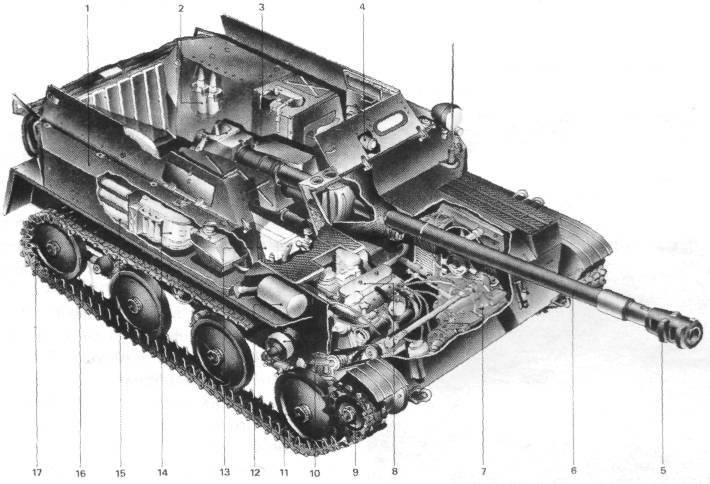
1 - body; 2, 15 - laying ammunition; 3, 13 - gas tanks; 4 - optical sight; 5 - muzzle brake; 6 - gun barrel (H-51M); 7 - power unit; 8 - M-20E engine; 9 - drive wheel; 10 - supporting video; 11 - track roller; 12 - muffler; 14 - air cleaner; 16 - balancer rear support roller with a mechanism for adjusting the tension of the caterpillar; The 17 is a rear track roller (steering wheel).
In 1949, the shipyard 2 built a compact floating self-propelled gun K-73, developed by the OKB under the direction of A.F. Kravtsev. The mass of the machine was 3,4 t, height - 1,4 m. The armament of this machine was an 57-mm H-51 cannon with an OP2-50 sight, and a SG-7,62 X-mm machine gun coupled to it. The ammunition included 43 shells to the cannon, as well as 30 cartridges for machine guns. Armor thickness - 400 millimeters. The armor resistance was increased by the inclination of the front sheets of the cabin and the hull. In front of the hull, the transmission units and the GAZ-6 carburetor engine (power 51 hp) were installed. The propeller propeller located on the hinged shaft was the propulsion unit. In the stowed position, he was attached to the aft logging cabin. The maximum travel speed on land - 70 km / h, while overcoming water obstacles - 54 km / h. Kravtsev's self-propelled gun didn’t withstand the competition with the car, because it didn’t have enough maneuverability.
The first experienced ASU-57 (“572 object”) with the 57-M-51 millimeter cannon, which was created in OKB-40 under the supervision of D.I. Sazonov and N.A. Astrov, manufactured in 1948 at the plant number 40 (now ZAO Metrovagonmash). In April, the 1948 of the year was conducted by field testing, and in June of the 1949 of the year - by the army. 19 September 1951 was adopted by a decree of the USSR Council of Ministers ACS-57. Serial production of the machine began MMZ in 1951 year. The production of armored hulls was carried out by the crushing and grinding equipment plant (Drobmash, Vyksa, Gorky region). The AMS-57 was first introduced to the public by 1 on May 1957 in Moscow during a parade on Red Square.
ACS-57 was a half-closed tracked installation. The engine compartment was in front. Combined fighting compartment and office control were located in the aft hull. Ahead, to the right of the gun, there was a driver, behind him was placed a loader, and to the left of the gun was the commander (he is also a radio operator and a gunner).
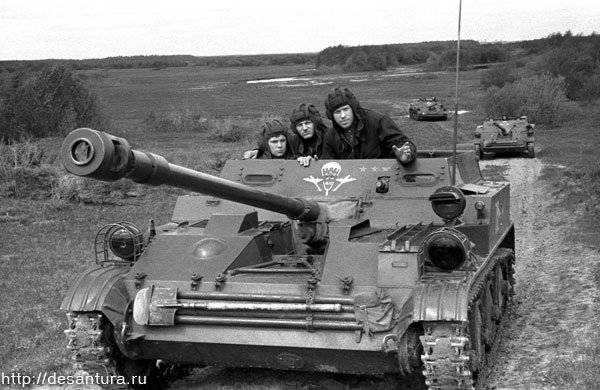
The H-51 gun was designed in the 1948 — 1950. in plant design bureau No. 106 under the direction of E.V. Carnko under the ammunition anti-tank guns ZIS-2. The gun had a barrel-monoblock with a cross-slit muzzle brake of reactive action, a vertical wedge gate with semiautomatic copying type, a hydropneumatic nakatnik and a hydraulic rollback brake. Manual loading. The gun was installed in the wheelhouse on the frame, which was attached to the bottom of the hull and the front sheet. Mask gun covered cover. Pointing angles from -5 to + 12 ° vertically and ± 8 ° horizontally. H-51 had screw guidance mechanisms. During direct-fire shooting (range 3,4 km), an optical sight OP2-50 was used, and from closed positions (range 6 km) - a panorama.
The ammunition consisted of fragmentation (shot weight - 6,79 kg, projectile - 3,75 kg), armor-piercing tracer (6,61 kg and 3,14 kg, respectively) and sub-caliber armor-piercing tracer (5,94 and 2,4 kg) projectiles. An armor-piercing projectile penetrated armor with a thickness of 85 millimeters at a distance of 1 km, sub-caliber (initial speed 1158 m / s) - 100-mm armor at a distance of 1 km and 72-mm at 2 km. The direct shot range of this projectile was 1060 meters. In the laying in the wheelhouse for action outside the car, the SGM or SG-43 machine gun was transported (on the ACS-76 company machine gun RP-46). Later in the packing drove AK or AKM.
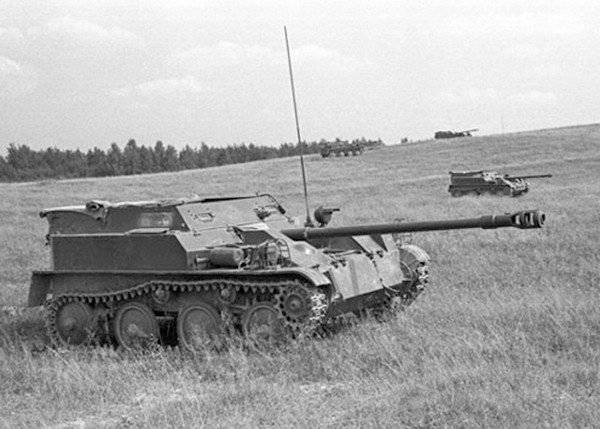
To reduce the weight of the ACS, aluminum alloys were used, and armor protection was kept minimal. The hull was assembled from steel armor plates (in the most critical places) and aluminum sheets (hull stern sheets and bottom) connected by welding and riveting. To reduce the height of the self-propelled guns side and upper front sheets felling reclined on the hinges. In the niches of the fighting compartment located on the fences, from the starboard side of the cabin there were compartments for a part of the ammunition set, and from the left side - for spare parts and batteries. The fighting compartment, as well as on other machines of this class, was covered from above with a canvas awning with a rear viewing window.
This machine has preserved the time-tested principle of using car units. The four-cylinder M-20E compact engine was a direct descendant of the passenger car "Victory". He developed the power of 50 horsepower at a frequency of 3600 rpm (this engine was also installed on the all-wheel drive GAZ-69). The engine was installed across the body of the car in a single unit with dry friction friction, four-speed manual gearbox and friction clutch. The power unit was mounted in a housing on four spring-loaded supports, and mounting using only four bolts accelerated the replacement. Onboard gears - simple gears. The engine location was shifted to starboard. It was closed by a flap armor with blinds. The exhaust pipe with a silencer was displayed in front of the hull from the starboard side. In the front left side of the case were placed oil and water radiators and a fan with a drive. They were also closed with a flap having air intake louvers. The gearbox cover was located in the middle part of the upper frontal armor plate of the body. Combined air cleaner. ASU-57 also had a preheater.
The undercarriage of the self-propelled gun as a whole repeated the undercarriage of the ACS-76. It included four single rubberized support rollers and two supporting rollers on each side. Each roller has an individual tubular rod torsion bar suspension. The front nodes are equipped with hydraulic shock absorbers connected to the balancers of the rollers by rods. The torsions of the three first starboard rollers are offset by 70 mm relative to the torsion of the left side. The drive wheel is located in front. The steering wheel is lowered to the ground. It is the fourth track roller. The balance of this roller is equipped with a screw mechanism for adjusting the track tension. The metal track chain, finely knit, with two crests, is made up of 80 204 millimeter tracks. By reducing the mass of the ASU-57 self-propelled gun compared with ASU-76, the best passability was obtained even with a smaller caterpillar width: ground pressure equal to 0,35 kgf / cm2 ensured high cross-country and swampy traffic. To protect the tracks, a removable wing was installed.
Inspection blocks B-2, located in the frontal heading, as well as observation windows, equipped with armor plates, in the side armor plates, were used for observation. ASU-57 was equipped with a radio station YURT-12 and TPU-47 (tank intercom) for three subscribers. The radio station was in front of the commander's seat. She worked on a whip antenna height 1 - 4 meters, located at the left side before chopping. Starting from 1961, the car was equipped with a P-113 radio station and a TPU P-120 intercom. The maximum range of radio communication is 20 km. Voltage on-board network - 12 B.
The ASU-57 self-propelled artillery installation combined small dimensions, good mobility and sufficient firepower. It can be said that Astrov, finally, managed to solve the task, over which many designers had fought since the 1930s - to combine the wedge and anti-tank gun.
The low silhouette of the ACS-57 contributed not only to its transportation, but also to disguise the terrain. The anti-tank company of the parachute regiment recited nine such installations. The inconspicuous and 57-millimeter cannon, which has sub-caliber armor-piercing projectiles in the ammunition, made it possible to fight medium tanks, which at that time formed the basis of a potential enemy tank fleet. On the armor of a self-propelled artillery installation could accommodate four paratroopers. In addition, it was used as a lightweight tractor.
The AMS-57 in 1954 was reequipped with a modified H-51M gun. The upgraded gun received an ejector and a dual-chamber active muzzle brake. The total length of the installation decreased by 75 cm. In addition, the extraction of the sleeves and the opening of the shutter was carried out at the end of the roll (at the H-51 - at the end of the rollback). The turning mechanism is equipped with a braking device. The latest series of ACS-57 were equipped with illuminated night-vision devices for the driver (the headlight with an IR filter was mounted above the right fender). In addition, an additional fuel tank was installed.
Floating option
Since September, the Astrov Design Bureau has been developing floating ACS-1951 modifications (in 57, an experienced floating ACS-1949 was created). The first ASU-76P prototype (57 object) was built in November 574 of the year. In 1952 — 1953, four more prototypes were assembled and tested. ASU-1954P (mass 57 t) differed from the prototype in an elongated body (3,35 m) of a streamlined shape. The buoyancy of the machine was provided by the displacement of the case. On the top front sheet there was a folding wave shield. ASU-4,255 thrusters were a forced engine (HP 57) and a propulsion unit. The self-propelled gun gun was also redesigned. The X-60P differed from the X-51M in its technological muzzle brake, the design of the lifting mechanism, the mechanism of the semi-automatic and breech. Trunk pads transferred forward to 51 mm. The rate of fire reached 22 — 11 shots per minute.
Initially, two propellers placed in the rear part were used as propulsion engines. They were driven by the rotation of the guide wheels, but when the machine reached the shore, the tracks lacked traction. In this regard, the choice was made in favor of the scheme with the selection of power from the gearbox to the propeller. The screw in this case was placed in a special niche in the bottom of the case. The steering wheel was placed in a single tunnel with a screw - by analogy with the T-40, developed on the eve of the war N.A. Astrov. A heat exchanger was added to the cooling system, which, while driving on water surfaces, provided heat removal to the outside water.
In 1955, the machine could be put into service, but it was never transferred to mass production. Only four copies were produced. Such a limited release was due to the fact that the power of the 57 millimeter cannon was insufficient, however, as well as extremely lightweight booking. At the same time, the ASU-57 serial production was rolled up. It was clear that the increased role of airborne assault forces and the development of potential enemy armored vehicles required the creation of a new machine with more powerful weapons.
In the OKB-40 on the ASU-57, they tentatively installed in place of the 57-millimeter cannon an 107-millimeter recoilless B-11 gun developed by the Shavyrin Design Bureau. The ammunition set of the experimental unit BSU-11-57F (mass of 3,3 t) included shots with cumulative and high-explosive fragmentation shells. Shooting was carried out with the help of an optical or mechanical (backup) sight. The maximum firing range - 4,5 thousand meters. And although in those years, recoilless weapons as amphibious assault forces aroused wide interest, the development of airborne self-propelled artillery mounts rightly followed the path of "classic" artillery systems.
The ASU-57 self-propelled guns were not forgotten after replacing with more powerful ones: some were used as trainers, some were converted into tractors (chassis components were previously used in the AT-P tractor).
Ways of landing ASU-57
After World War II, the main methods of landing airborne assault forces were considered: glider, parachute and landing. Landing of ASU-57 self-propelled artillery mounts was carried out by landing method on a platform having a multi-domed parachute system or Yak-14 gliders.
Heavy transport glider Yak-14 was developed in 1948 year in the Yakovlev design bureau. The glider could transfer ACS-57 and two members of its crew (the mass of the ACS-57 with a fully equipped ammunition and crew was about 3,6 thousand kg). ASU-57 drove into the glider through the bow hatch along the ladders. At the same time, the nose of the fuselage swung to the side (to facilitate loading, the air from the landing gear supports was etched, thus the fuselage was lowered). Inside the installation was fastened with cables. To prevent rocking during transport in an airplane or glider, the extreme suspension assemblies of the self-propelled gun were blocked onto the hull. For towing glider Yak-14 aircraft used IL-12D. In addition, an experienced Tu-4T was considered as a tug.
The lack or absence of amphibious vehicles having an average carrying capacity forced them to severely limit the weight of the airborne self-propelled guns. This causes the small size of the hull (the height of the frontal sheet and the sides of the cabin was small) and the thickness of the reservation.
In the 1956, the P-4M suspended cabin was used for the Tu-98D transport aircraft, which was used to drop ASU-57, but this cabin was soon converted into an XDUMX mm SD-85 gun. But the “landing” modifications of the bombers and passenger aircraft were already being replaced by transport aircraft designed specifically for this purpose.
After adopting the An-1959 transport developed by GSOKB-12 in Antonov 473, the situation changed. The new aircraft significantly expanded the capabilities of the landing forces, providing parachute or landing landing of equipment, including ASU-57, and personnel. The An-12B aircraft for dumping of amphibious cargo systems was equipped with a TG-12 roller conveyor. ASU-57 were parachuted using a parachute platform developed in the Design Bureau of Plant No. XXUMX (Moscow Aggregate Works Universal) under the guidance of Privalov, with the MKS-468-5Р or MKS-128-4 multi-dome systems. The self-propelled gun was fastened with cables with mooring devices on PP-127-128 (when dropped from An-500B), later - on П-12 (from Il-7, An-76 and An-22Б). To prevent deformation and damage, the self-propelled gun under the bottom was fixed with supports. The total flight mass of the PP-12-128 platform with the fully-loaded ASU-5000 ASM installed on it was 57 kilograms. An-5160B was able to take on board a pair of stationed on the platforms ACS-12.
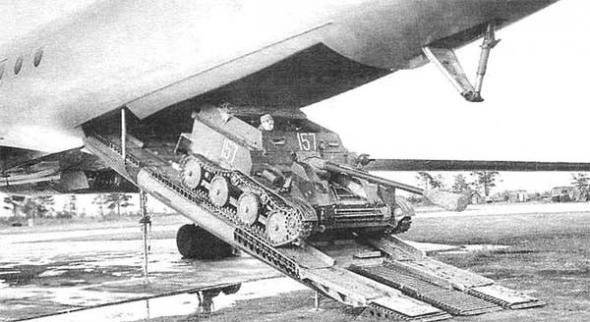
The release took place in several stages. At the first stage, the platform was removed from the aircraft with a cargo parachute. At the same stage, the stabilizing parachute began to work. The platform descended on the enlarged main domes and a stabilizing parachute. At the next stage, the main domes were divided, filling them with air. At the last stage - the decline on the main parachutes and landing. At the moment of touching the ground, the platform was depreciated. In this automatic uncoupling disconnected the main parachutes. The release from MKS-5-128Р occurred at a height from 500 to 8 thousand meters. The descent rate was about 7 m / s. The platform was equipped with a marker radio transmitter P-128, which allowed to detect it after landing.
The self-propelled gun was also transported by the heavy Mi-1959 helicopter that appeared in 6, developed by the Mil Design Bureau.
ASU-57 took part in all the major exercises of the airborne troops. In the “Rossiyskaya Gazeta” there was a reference to the fact that the ACS-57 was used in military exercises with the use of nuclear weapons, which were held at the Semipalatinsk test site 10 September 1956 of the year. ASU-57 also exported to Egypt.
ACS-57 has become a kind of "test bench" for the development of airborne armored vehicles. For example, in 1953 — 1954, at SRI No. 22 PBTT (now 38-s NIII), the ASU-57 AMS tests were carried out: using the KT-12 crane, the self-propelled device was dropped several times to determine the maximum allowable overloads for different landings. In the course of those tests, it was found that the ultimate overload equals 20g. Later, this figure entered the GOST for amphibious systems.
It should be noted that in the 1951 year, when the ACS-57 was put into service, the Airborne Troops Flight Test Division was transformed into the Technical Committee of Command. One of its departments was engaged in ground engineering, automotive, artillery and armored vehicles. This fact in itself testified to the increased attention to the technical equipment of this kind of troops. In 1954, General Margelov became commander of the airborne troops. The 25 years during which he held this post became the time for the development of the Airborne Forces, the qualitative improvement of their military equipment and weapons. In 1962, the Technical Committee was transformed into the Experimental Equipment Division of the Office of the Commander of the Airborne Forces. In 1964, the Division was reorganized into the Scientific and Technical Committee of the Airborne Forces.
SU-85
A lightweight 85 self-propelled self-propelled gun was developed for solving support tasks and anti-tank guns of tank and motorized rifle subunits (later 90-millimeter self-propelled gun Yagdpantser had a similar purpose in the Bundeswehr of the Federal Republic of Germany), and as an anti-tank self-propelled artillery installation of airborne units. However, the main role for her was precisely airborne. Work on the machine, which received the name "573 object", was started in 1953 year. The self-propelled gun was created at the Mytishchi machine-building plant on an original base, developed under the leadership of Astrov. In 1956, it was put into service under the designation SU-85 (the designation ACS-85 was also used).
At this time, the layout was chosen with the rear placement of the logistics and front placement of the combat compartment (as before it was combined with the control compartment) in a fixed wheelhouse. To the right of the cannon in its front part there was a driver-mechanic, behind him - the loader and the commander, on the left - the gunner.
The 85 mm D-70 cannon was mounted in a frontal logging frame in a frame with a spherical mask covered by a boot. She was slightly offset to the left of the longitudinal axis of the self-propelled gun. The gun was created at the OKB Plant No. XXUMX under the direction of Petrov. Serial production involved plant number XXUMX in the city of Yurga. The D-9 gun had a monoblock-barrel, an active two-chamber muzzle brake, an ejector for purging, a vertical wedge gate having copy-type semi-automatics. The recoil device included a hydraulic recoil brake, as well as a hydropneumatic knurler with a valve for additional braking. The gun was charged manually. Target angles: ± 75 ° horizontally, from -70 to + 15 ° vertically. The mechanism of vertical guidance sector, horizontal screw. The flywheel of the lifting mechanism was placed under the gunner under the right hand, and the turning mechanism under the left. On the handle of the flywheel of the lifting mechanism there was an electric trigger lever, which was duplicated by manual descent. The articulated telescopic sight TSHK4,5-15-2 was used during direct fire. For shooting from closed positions used mechanical sight C-79-11 with a gun panorama PG-71. For different types of shots, both sights had scales. When firing a direct fire, the range was 79 thousand meters, with a maximum elevation angle, the target range was 1 thousand meters, the maximum range when using high-explosive fragmentation shells was 6 thousand meters -10-13,4 equipped with an infrared illuminator L-1.
The ammunition consisted of unitary shots of various types, similar to the D-48 ammunition. However, the D-70 barrel was shorter than the D-48 on 6 calibers, which affected ballistics. UBR-372 carried 9,3 kg armored-piercing tracer projectile BR-372, the initial speed of which was 1005 m / s. This projectile could pierce armor thickness up to 1000 millimeters at an angle 200 ° at a distance of 60 meters. 3UBK5 carried 7,22 kilogram cumulative projectile 3BK7, punched 150 millimeter armor. This made it possible to fight with tanks Centurion Mk III or МХNUMXА48 Paton III. UOF-2 carried 372 kilogram high-explosive fragmentation projectile OF-9,6, which was intended to destroy fortifications and destroy enemy manpower as well as reduced charge. In addition, there were shots with practical and smoke projectiles. The mass of the shot was no more than 372 kilograms. The shots were placed in the fighting compartment: at the MTO partition in the niche - 72 pcs., Along the partition - 372 pcs., On the left side of the hull - 372 pcs., In the niche of the starboard - 372 pcs., In the niche of the left side and in front of the gunner - on 21,9 pcs.
It should be noted that the SU-85 was almost as good as the medium tanks in firepower, and the lower protection of the vehicle was compensated for by small dimensions. The SGMT 7,62 machine gun was paired with a gun. The ribbons for the machine gun (each for 250 cartridges) were in eight box-stores. The AKM machine gun and the 300 cartridges for it, the signal pistol SSP, 15 grenades F-1 fumbled in the car.
The welded hull had rational angles of the onboard and frontal armor plates. The hull provided protection against armor-piercing shells of medium and small caliber. Additional body stiffness was attached to a corrugated bottom having a trough-shaped form in cross section. The bottom had a hatch designed for emergency evacuation of the crew. On the brackets of the top frontal sheet, a board was installed that performs the functions of a mud breaker plate.
The power unit was quick-change. The continued stringent requirements of the use of automotive industry units forced designers to use the YAZ-206В automotive diesel two-stroke engine, which developed the 210 hp. at 1800 rpm The engine was mounted across the hull and was shifted to the starboard side. The gun and engine balanced each other. To reduce power losses, a generic, but not requiring a power take-off liquid cooling system with ejection ventilation was used. There was a nozzle preheater and three multi-cyclone air filters. The engine was started by electric starter. Access to the engine was provided by folding top covers MTO.
The mechanical transmission consisted of the main clutch, gearbox, propeller shaft, five-speed gearbox, planetary turning mechanisms and final drives (single-stage gearboxes). At first, the single-disc main clutch was used, however, in the course of operation, a part of the machines was equipped with multi-disc clutches that were more reliable. The gearbox was used automobile, but so modified that the percentage of use of automobile units in the self-propelled gun was not significant as a result. The transmission had five forward speeds and one reverse. Planetary rotation mechanisms (PMP) were two-stage, and had brakes and blocking friction. With the left PMP, the gearbox was connected with a gear and a coupling, with the right - with a semi-axle. A mechanic-driver for controlling a self-propelled artillery installation used the control levers of the PMP, gear lever, oil pump and engine stop, brake pedals, fuel supply and the main clutch. The chassis consisted of six single rubberized road wheels on board (like a PT-76 tank) with an individual torsion suspension and hydraulic double-acting shock absorbers at the sixth and first suspension nodes. The drive wheels were located behind. Torsion bars went from side to side. Caterpillar fine-molded, metal, with two crests, lantern gear. The track tape consisted of 93 steel forged tracks.
SU-85 for observation was equipped with inspection units B-1 (one for the gunner and loader, two for the driver). The commander also had an active night vision device TKN-1T, and the driver was TVN-2. IR illuminators were fixed above the driver's seat, as well as above the gun mask. Internal communication was carried out by TPU P-120, external - by radio station P-113. When working on a whip antenna height 1 - 4 meter, it provided communication at a distance of 20 km. The antenna was mounted on the starboard. On-board network - 24 B. The smoke screens were installed by two smoke bombs BDSH-5 mounted on the hull rear stern. Dropping occurred without leaving the crew. The stern also fastened two additional fuel tanks providing an increase in power reserve. Spare parts and tools stacked on the sides of the hull and in the fighting compartment. OU-5В fire extinguisher was also located in the fighting compartment.
Su-85 self-propelled guns were mass-produced up to the 1966 year. Each airborne division had a self-propelled artillery division that included the 31 SU-85.
Initially, the cutting house self-propelled was open at the top. This allowed to reduce the height and facilitate its weight. But in 1960, for better protection (including protection against weapons of mass destruction - this requirement became mandatory), a roof with four hatches and a filtering unit were installed. The cap of the supply fan was located above the embrasure of the instrument, followed by the air intake housing. In the roof for the commander mounted periscopic device TNPK-240A having 8-fold optical zoom system. Since the SU-85 was created as half-closed, the addition of its cover somewhat hampered the fighting compartment. Nevertheless, the airborne SU-85 troops liked because of the reliability and good mobility. In addition to fighting armored vehicles and tanks, the SU-85 solved the tasks of direct fire support, as well as carrying troops on armor. The paratroopers willingly used this transport before the appearance of their own transport and combat vehicles.
* The release of SU-85 in a half-closed version began in 1956.
** K - carburetor, D - diesel, B - air, W - liquid cooling
When the SU-85 self-propelled artillery installation began to enter service, the An-12 transport aircraft was prepared for the first flight, which was capable of transporting such a vehicle. During loading into the aircraft, the torsion bar was switched off using the tool of the machine that was part of the spare parts kit. To transfer the SU-85 from the marching position to the combat position it was required from 1 to 1,5 minutes. SU-85 primarily calculated on landing landing. This significantly limited the combat capabilities of this vehicle. Ammunition to the landing force could be dropped by An-12B aircraft. For this purpose, the PP-128-5000 platforms equipped with the MKS-5-128М multi-dome systems were used. For example, a GAZ-66 car landed, carrying 85-millimeter shots packed in boxes in its back.
In 60, airborne landing (including the operational depth of enemy formation) was a permanent element in the construction of armies. The depth of landing has increased, the requirements for landing speed have increased, as well as the time for independent actions.
In this regard, the release of armored vehicles was carried out as part of the landing. Since 1961, work has begun on expanding the possibilities of transporting military equipment and landing facilities. After the appearance of the P-16 platforms (maximum flight weight - 21 thou. Kg), it became possible to land the SU-85 from the An-2 not only by the landing method, but also on a platform having a multi-dome system. However, a new generation of combat vehicles was already replacing self-propelled artillery mounts.
SU-85 self-propelled artillery mounts were exported to Poland. In 1967, self-propelled guns participated in the Arab-Israeli Six-Day War on the Arab side. The experience of combat use has shown the need for the availability of means of self-defense against army helicopters and attack aircraft. In 1970-s, anti-aircraft 85-mm DShKM machine guns with a collimator sight were installed on the roof of the SU-12,7 self-propelled guns. SU-85 participated in other military conflicts, including the introduction of troops in 1968 to Czechoslovakia (admittedly, the Soviet Airborne Forces in that operation demonstrated excellent training, as well as the ability to act quickly and competently) and the war in Afghanistan. Su-85 was removed from service in 1993 year.
The development of self-propelled anti-tank artillery systems ceased as the effectiveness of anti-tank systems (anti-tank missile system) increased, and paratroopers for fire support units received a completely different machine.
Of the foreign self-propelled artillery mounts, we should mention the American open 90-mm self-propelled gun M56 "Scorpion", which was produced in 1953 — 1959 almost simultaneously with the ACS-57 and SU-85. In the American self-propelled gun, a different approach to the creation of such machines is demonstrated: a powerful anti-tank gun mounted on a light chassis and having armor, limited only by a shield. It should be noted that the later Sheridan М551 airborne tank equipped with a 152-millimeter cannon launcher had the character of an “anti-tank gun
Literature
1. Baryatinsky M. Soviet armored vehicles 1945 — 1995 (part of 2). Armored collection / 2000. No.4 (31).
2. Varaksin Yu.N., Bach I.V., Vygodskiy S.Yu. Armored vehicles of the USSR (1920 — 1974). - M .: Central Research Institute of Information, 1981.
3. Airborne: yesterday, today, tomorrow. Militaryhistorical essay, the city of Mines, Russian Bear, 1993.
4. Gerasimenko I.A. Airborne training. H. 1 and 2. - M .: Military Publishing, 1988.
5. Gribovsky G.V. The development of transport gliding. - M .: Mashinostroenie, 1993.
6. Karpenko A.V. Domestic self-propelled artillery and anti-aircraft installations. - SPb .: Nevsky Bastion, 2000.
7. Kondratyev V. The most massive fighter // World Aircraft. 1996. No.1.
8. Nersesyan M.G., Kamentseva Yu.V. Armored vehicles of the armies of the USA, England and France. - M: Military Publishing, 1958.
9. Rossiyskaya Gazeta, 26 May 1994
10. Su-Xnumx. Material Guide, 85
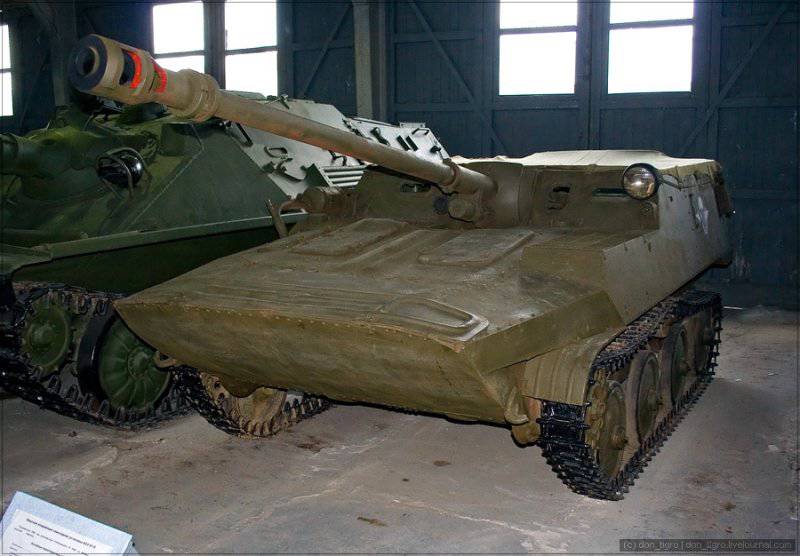
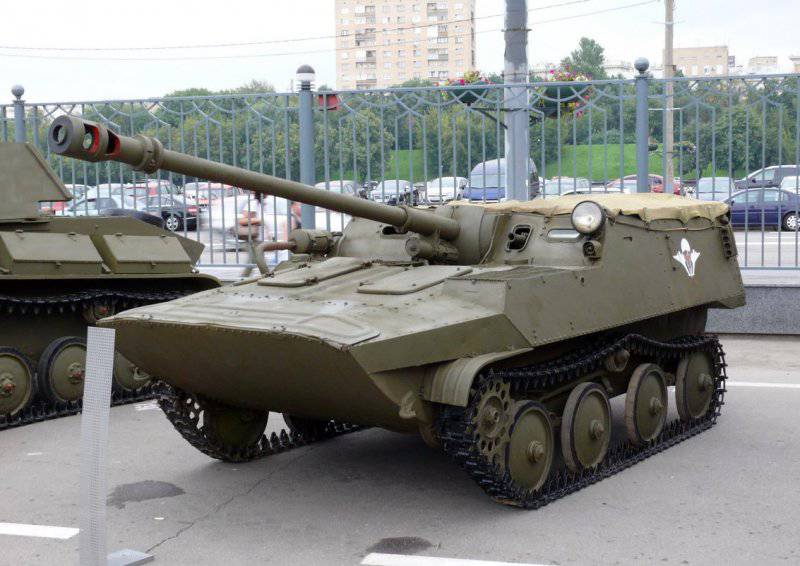
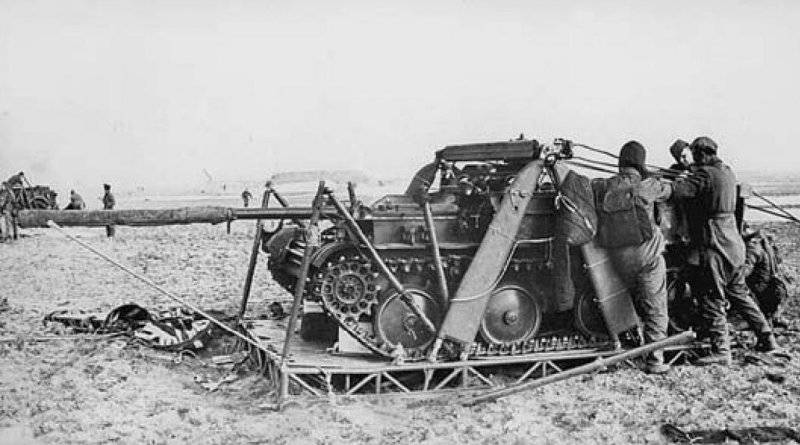
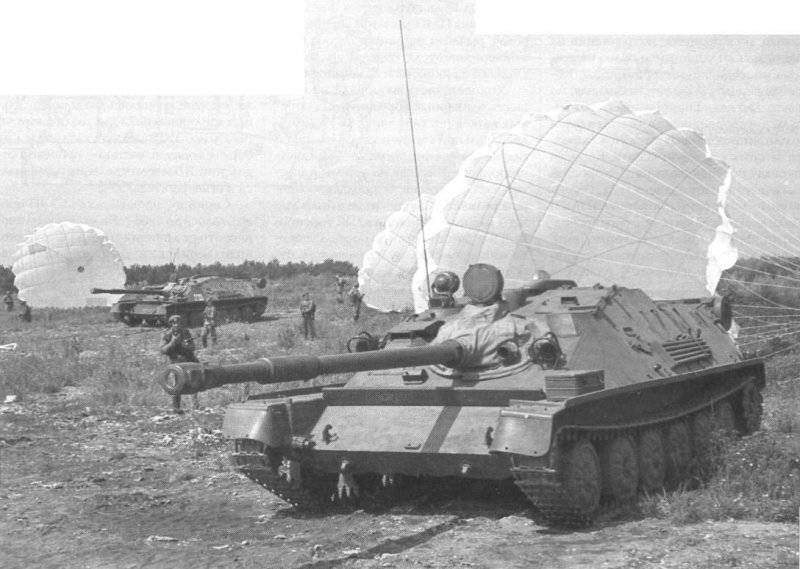

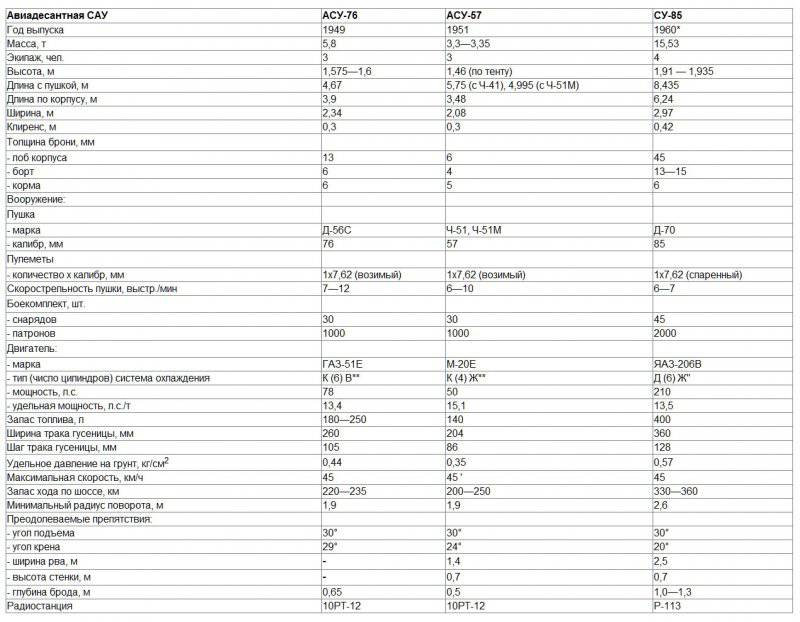
Information